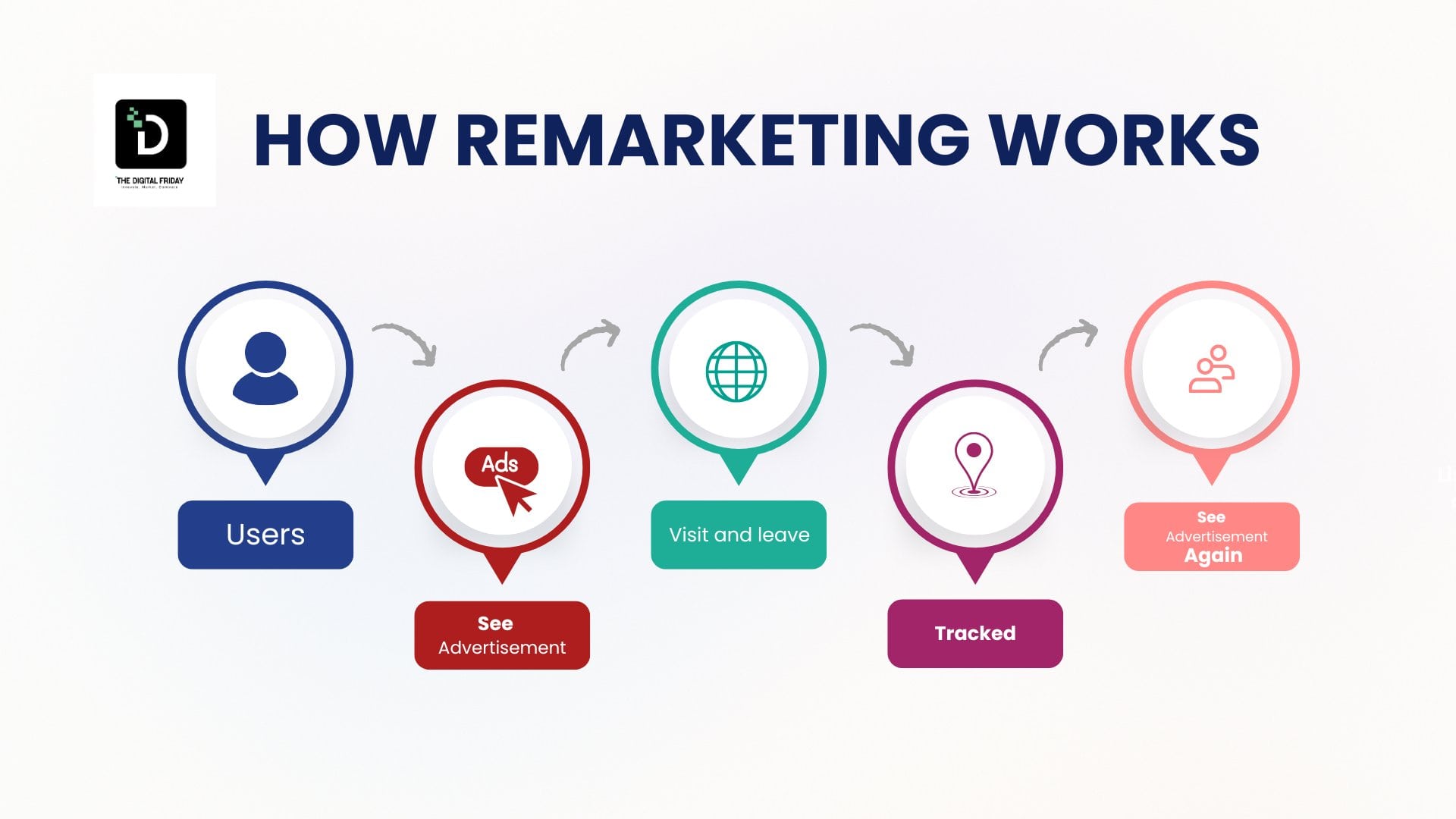What Is Remarketing in Digital Marketing?
Remarketing is a digital marketing method that goes after people who have already interacted with your brand but didn’t buy anything. In 2025’s changing digital ecosystem, this is a key strategy since it re-engages warm audiences, increases conversion rates, and improves ROI by showing tailored advertising on sites like Google, Facebook, and email. We can also called it retargeting .
How Remarketing Works ?
People who see your ad and feel some interest to go to your website, but they didn’t do ad to cart or click even on any product. Cookies or other event tracking mechanisms keep track of their visits, which lets you see what they are interested in. Later, when they look at social media, your ad comes up again, targeting them based on their last visit. This plan maintains your brand in front of them, which makes them want to come back and purchase. It’s a short cycle of exposure, tracking, and re-engagement to get more people to buy.

Difference between Remarketing VS Retargeting
When you use digital marketing agency, not every person turns into a customer right away. When a lot of people go to a website, they look at the goods or services and then leave without buying anything. Remarketing and retargeting are two smart ways for marketers to get those possible customers to come back.
| Factor | Remarketing | Retargeting |
|---|---|---|
| Definition | Re-engaging users via email or direct outreach after previous interaction | Serving paid ads to users who visited your website or app but didn’t convert |
| Medium | Remarketing usually applied on Email Marketing | It is for Website visit,display ads, search ads, or social media ads |
| Data Source | Uses on customer databases | Uses cookies, pixels, or website behavior |
| Example | Sending a cart abandonment email | Showing a Facebook ad for a product a user viewed |
| Platform | Email platforms | Ad platforms . Example – Facebook Ads, Google Ads, TikTok Ads |
| Objective | Bring users back via personalized messages | Bring users back through visual reminders |
| Triggered | When user gives email or signs up | When user visits website/app but doesn’t convert |
Why Remarketing Matters in 2025
Businesses can change the game with remarketing because it can increase sales, boost brand recall, and get the most out of their advertising budget. In 2025, this is why it’s important:
- Higher Conversion Rates: Because they’ve already shown interest in your brand, remarketing targets people who are 70% more likely to buy than new visitors.
- Cost-effective Advertising: Remarketing gives a better return on ad spend (ROAS) because it focuses on warm leads instead of cold viewers. Remarketing has been shown to increase sales by as much as 20%.
- Cart Abandonment: Seventy percent of online buyers leave items in their shopping carts without finishing their purchases. Remarketing helps make up for lost sales by reminding users to finish their purchases.
- Recall: Personalized ads that show the same brand to users over and over again make people more comfortable with it, which makes them more likely to choose your business over competitors.
- Dealing with Cookie Deprecation: Third-party cookies will no longer be used after 2025. Since remarketing relies on first-party data plans, it’s important for businesses to collect and use their own data.
Types of Remarketing Strategies
Remarketing encompasses various approaches to re-engage users. Here are the key types to consider in 2025:
- Standard Remarketing: Displays ads to users who visited your website as they browse other sites on ad networks like Google Display Network, reaching 90% of U.S. internet users.
- Dynamic Remarketing: Shows personalized ads featuring specific products or services users viewed, ideal for e-commerce businesses. For example, a user who browsed a pair of shoes sees an ad for those exact shoes.
- Remarketing Lists for Search Ads (RLSA): Customizes search ad campaigns for users who previously visited your site, allowing tailored bids and messaging.
- Video Remarketing: Targets users who interacted with your video content (e.g., YouTube videos) with ads on YouTube or other Google sites.
- Social Media Remarketing: Reaches users who engage with your brand on platforms like Facebook, Instagram, or LinkedIn, either within the platform or via SERPs.
How to Create an Effective Remarketing Campaign
Building a successful remarketing campaign in 2025 requires strategic planning and optimization. Follow these steps:
- Set Clear Goals: Define objectives, such as increasing sales, reducing cart abandonment, or boosting app downloads. Clear goals guide your campaign structure.
- Segment Your Audience: Use data like pages visited, time spent, or actions taken to create targeted audience segments. For example, segment cart abandoners separately from homepage visitors.
- Leverage First-Party Data: With third-party cookies phasing out, collect first-party data via website interactions, CRM tools (e.g., HubSpot), or social media pixels to build lookalike audiences.
- Craft Personalized Ads: Tailor ad content to user behavior. For instance, offer discounts to cart abandoners or showcase related products for upsell opportunities.
- Choose the Right Platforms: Use Google Ads for display and search remarketing, Meta for social media, or email platforms like MailChimp for email campaigns.
- Track and Optimize: Use analytics tools (example – Google Analytics) to monitor performance metrics like click-through rates (CTR) and conversions. Adjust underperforming ads to improve results.
- Test Creative Variations: Experiment with ad formats (e.g., video, carousel) and messaging to find what resonates with your audience.
Conclusion
Remarketing plays a key role in digital marketing in 2025 as it helps businesses boost brand recall, increase sales, and reduce cart abandonment. You can make campaigns that really connect with your audience by using first-party data, customizing ads, and making sure they work best on mobile and new platforms. Start using these tactics right away to stay ahead in the digital world, which is very competitive. You could work with a digital marketing agency or look at tools like TICE India or SEO.com for professional advice. Want to get your audience’s attention again? Start your plan for remarketing right away!
FAQ


